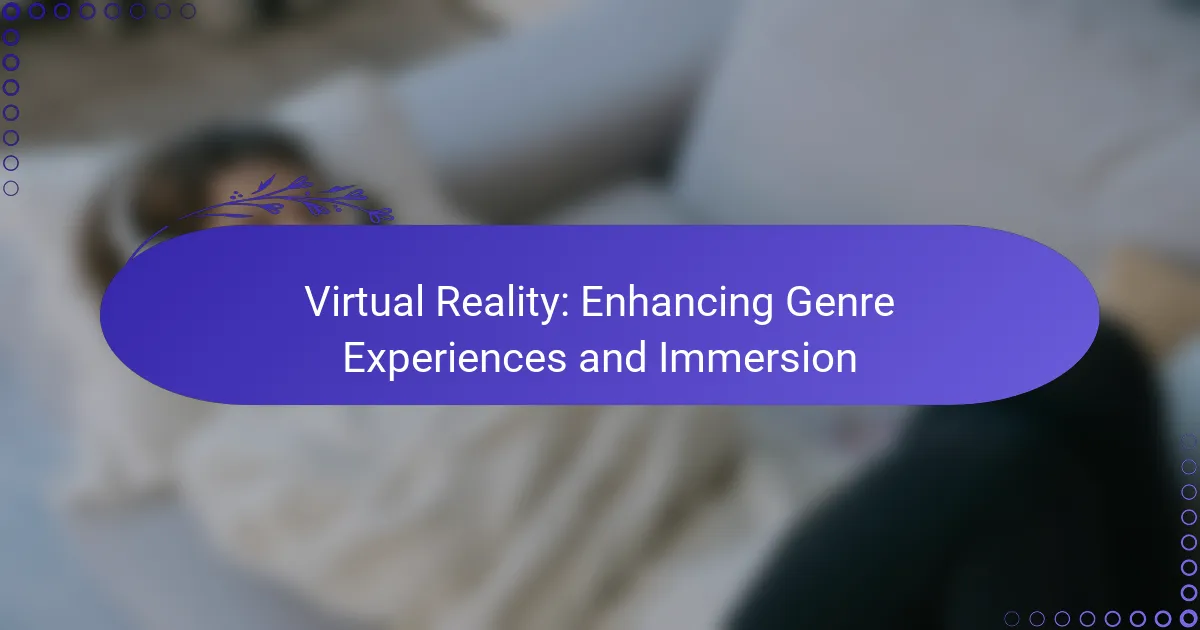Virtual reality (VR) transforms the gaming landscape by immersing players in richly detailed worlds that engage multiple senses. By enabling interactive experiences that traditional gaming cannot match, VR enhances engagement across various genres, including action-adventure, simulation, horror, and education. Key technologies such as head-mounted displays and motion tracking sensors work in tandem to create a compelling and realistic environment, elevating the overall gaming experience.

How does virtual reality enhance gaming experiences?
Virtual reality (VR) significantly enhances gaming experiences by creating immersive worlds that engage players on multiple sensory levels. This technology allows gamers to interact with their environment in a way that traditional gaming cannot, leading to deeper engagement and enjoyment.
Immersive environments
Immersive environments in VR transport players into richly detailed worlds that feel real. These environments often include 360-degree visuals and spatial audio, which help players feel as if they are truly part of the game. For example, exploring a fantasy realm or a post-apocalyptic city becomes a visceral experience, engaging both sight and sound.
To maximize immersion, developers often use realistic physics and dynamic weather systems, making the virtual world more believable. This level of detail can significantly enhance the emotional impact of the game, drawing players deeper into the narrative.
Interactive gameplay
Interactive gameplay in VR allows players to manipulate objects and influence their surroundings in intuitive ways. Using motion controllers, players can pick up items, solve puzzles, or engage in combat, creating a sense of agency that is often missing in traditional gaming. This hands-on interaction fosters a more engaging and personalized experience.
Games designed for VR often include mechanics that require players to move around physically, which can enhance both the fun and the challenge. However, developers must balance complexity with accessibility to ensure that players of all skill levels can enjoy the experience.
Realistic graphics
Realistic graphics in VR are crucial for creating believable worlds that captivate players. High-resolution textures, detailed character models, and lifelike animations contribute to a sense of presence. As technology advances, VR graphics continue to improve, making experiences more visually stunning and immersive.
To achieve high-quality graphics, developers often optimize their games for specific VR hardware, ensuring smooth performance and reducing latency. This optimization is essential, as even minor delays can disrupt immersion and lead to discomfort for players.
Social interaction features
Social interaction features in VR enhance gaming by allowing players to connect with others in shared virtual spaces. Multiplayer VR games enable players to communicate and collaborate in real-time, fostering a sense of community. Features like voice chat and customizable avatars further enrich these interactions.
Developers should consider implementing social dynamics that encourage teamwork and competition, as these elements can significantly enhance the gaming experience. However, it’s important to ensure that social features are user-friendly and accessible to all players, regardless of their experience level.

What genres benefit most from virtual reality?
Virtual reality (VR) significantly enhances immersion and engagement across various gaming genres. The most notable genres that benefit from VR include action-adventure, simulation, horror, and educational experiences, each leveraging VR’s unique capabilities to create more compelling interactions.
Action-adventure games
Action-adventure games thrive in virtual reality due to their emphasis on exploration and interaction. Players can physically navigate environments, making the experience more engaging and realistic. Titles like “Beat Saber” and “The Walking Dead: Saints & Sinners” exemplify how VR can elevate gameplay through immersive storytelling and dynamic combat.
When developing or playing action-adventure games in VR, consider the importance of intuitive controls and comfortable movement options to prevent motion sickness. Ensuring a smooth frame rate and responsive interactions is crucial for maintaining immersion.
Simulation games
Simulation games benefit immensely from VR by allowing players to experience realistic environments and scenarios. Games such as “Microsoft Flight Simulator” and “Job Simulator” enable users to engage with intricate systems in a lifelike manner. The tactile feedback and spatial awareness provided by VR create a more authentic simulation experience.
For optimal enjoyment in simulation games, focus on hardware compatibility, as high-quality VR headsets can significantly enhance realism. Additionally, consider the learning curve associated with complex simulations, which may require tutorials or guided experiences to ease new players into the mechanics.
Horror games
Horror games leverage virtual reality to amplify fear and tension, immersing players in terrifying scenarios. Titles like “Resident Evil 7: Biohazard” and “Phasmophobia” use VR to create a sense of presence that traditional gaming cannot match, making players feel as if they are truly part of the horror. The ability to look around and interact with the environment heightens the emotional impact.
When engaging with horror games in VR, be mindful of personal comfort levels, as the intense experiences can be overwhelming. It’s advisable to take breaks and adjust settings to suit individual preferences, ensuring a balance between thrill and enjoyment.
Educational experiences
Educational experiences in virtual reality offer immersive learning opportunities that can enhance understanding and retention. Programs like “Google Earth VR” and “Titanic VR” allow users to explore historical sites or scientific concepts in a hands-on manner. This interactive approach can make learning more engaging and effective.
To maximize the benefits of educational VR experiences, ensure that content is well-structured and accessible. Incorporating interactive elements and assessments can further enhance the learning experience, making it more memorable and impactful for users of all ages.

What are the key technologies driving VR immersion?
The key technologies driving virtual reality (VR) immersion include head-mounted displays, motion tracking sensors, and haptic feedback devices. These components work together to create a realistic and engaging experience that transports users into virtual environments.
Head-mounted displays
Head-mounted displays (HMDs) are essential for delivering immersive visuals in VR. They typically feature high-resolution screens and wide field-of-view optics, which enhance the sense of presence in a virtual world. Popular models like the Oculus Quest and HTC Vive provide varying levels of performance and comfort, making it crucial to choose one that fits your needs.
When selecting an HMD, consider factors such as resolution, refresh rate, and weight. A higher resolution improves clarity, while a refresh rate of at least 90 Hz can reduce motion sickness. Ensure the fit is comfortable for extended use, as this can significantly affect your overall experience.
Motion tracking sensors
Motion tracking sensors capture the user’s movements and translate them into the virtual environment, enhancing immersion. These sensors can be built into the HMD or placed around the room, allowing for both positional and rotational tracking. Systems like inside-out tracking use cameras on the HMD, while outside-in tracking relies on external sensors.
For optimal tracking, ensure your play area is well-lit and free from obstructions. Some systems offer room-scale tracking, allowing users to move freely within a designated space, while others may be limited to seated or standing experiences. Understanding the tracking capabilities of your system is key to maximizing immersion.
Haptic feedback devices
Haptic feedback devices provide tactile sensations that enhance the realism of virtual interactions. These can range from simple handheld controllers to full-body suits that simulate touch and movement. Devices like the Valve Index controllers offer precise feedback that corresponds to in-game actions, making experiences more engaging.
When integrating haptic feedback, consider the type of experiences you want to enhance. For gaming, controllers with advanced haptics can significantly improve gameplay, while full-body suits may be more suitable for training simulations. Be aware that more advanced haptic systems can be costly, so weigh the benefits against your budget and intended use.

How do user experiences differ in VR vs traditional gaming?
User experiences in virtual reality (VR) significantly differ from traditional gaming by offering immersive environments that engage players on multiple sensory levels. While traditional gaming relies on screens and controllers, VR places players directly into the game world, enhancing the overall experience.
Increased engagement
VR creates a sense of presence that traditional gaming cannot match, leading to higher levels of engagement. Players can look around and interact with their surroundings, making the experience feel more real and captivating. This heightened engagement often results in longer play sessions and a deeper connection to the game narrative.
For instance, VR games like “Beat Saber” require players to physically move and react, which keeps them actively involved rather than passively observing a screen. This active participation can lead to a more fulfilling gaming experience.
Enhanced emotional responses
Emotional responses in VR are often more intense due to the immersive nature of the medium. Players can experience fear, joy, or excitement in a more visceral way, as the environment feels tangible. This emotional depth can lead to memorable moments that resonate long after the game is over.
For example, horror games in VR can evoke genuine fear as players feel they are truly within the terrifying scenarios, unlike traditional games where the experience is more detached. This emotional engagement can significantly impact how players perceive and remember the game.
Physical interaction
Physical interaction in VR allows players to use their bodies to control the game, which adds a layer of realism. Unlike traditional gaming, where inputs are limited to buttons and joysticks, VR often incorporates motion tracking and hand gestures, making actions feel more intuitive.
Games like “Half-Life: Alyx” utilize physical interactions to solve puzzles and engage in combat, requiring players to physically reach out and manipulate objects. This type of interaction can enhance the sense of agency and satisfaction in gameplay, making it a key aspect of the VR experience.

What are the challenges of implementing VR in gaming?
Implementing virtual reality (VR) in gaming presents several challenges, primarily due to high hardware costs and the complexity of content development. These factors can hinder widespread adoption and limit the quality of VR experiences.
High hardware costs
The cost of VR hardware can be a significant barrier for both developers and consumers. High-quality VR headsets often range from several hundred to over a thousand USD, depending on features and capabilities. Additionally, powerful computers or consoles are typically required to run VR games smoothly, which adds to the overall expense.
Developers must also consider the investment in VR-specific equipment, such as motion sensors and tracking systems, which can further increase costs. This financial burden can limit the number of developers willing to create VR content, impacting the variety of available games.
Content development complexity
Creating VR content is inherently more complex than traditional game development. Developers must design immersive environments that account for user movement and interaction in three-dimensional space. This requires specialized skills in 3D modeling, animation, and programming, which can be a steep learning curve for many.
Moreover, testing VR games can be time-consuming, as developers need to ensure that experiences are comfortable and free from motion sickness. Balancing visual fidelity with performance is crucial, as low frame rates can lead to discomfort for players. As a result, the development process can take significantly longer and require more resources compared to standard games.
